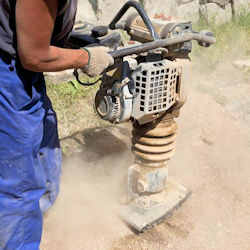Vibration
Various kinds of tools may cause vibration that could lead to "white finger" or hand-arm vibration syndrome (HAVS).
Injuries due to excessive vibration are especially dangerous when proper damping techniques are not applied, if machines are not maintained, if tools are not alternated, or if a worker uses a vibrating tool for consecutive hours during a workday. Workers need to be trained on the hazards of working with vibrating tools, and should always allow the tool or machine to do the work.
Controls to help reduce vibration hazards include vibration isolators or damping techniques on equipment, isolating machine vibrations from the work surface, and use of dampening material. Also, make sure rotating shafts are balanced, restrict the duration of exposure, and train workers on the hazards of vibrating parts.
Avoiding Hazards
Ergonomic hazards are avoided primarily by the effective design of a job or jobsite and better designed tools or equipment that meet workers' needs in terms of physical environment and job tasks. Through worksite analyses, employers can set up procedures to correct or control ergonomic hazards by:
- using the appropriate engineering controls (e.g., designing or re-designing work stations, lighting, tools, and equipment);
- teaching correct work practices (e.g., proper lifting methods);
- employing proper administrative controls (e.g., shifting workers among several different tasks, reducing production demand, and increasing rest breaks); and,
- if necessary, providing and mandating personal protective equipment. Evaluating working conditions from an ergonomics standpoint involves looking at the total physiological and psychological demands of the job on the worker.
Knowledge Check Choose the best answer for the question.
2-10. Which of the following is NOT effective in reducing vibration hazards?
You forgot to answer the question!

